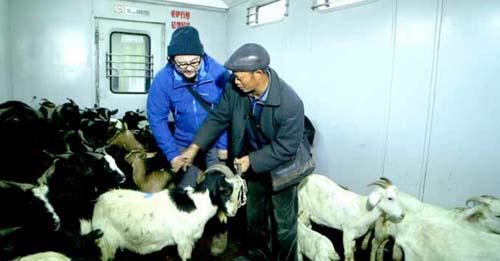Moving Museums
2018-11-15
CP: What were the most impressive stories you encountered while shooting the documentary?
Ren Chongrong: The documentary is built around a series of travel stories, so many interesting things happened during shooting.
In the first episode, the Shanghai-based online writer Qi Dong tracked down a DF1 (Dongfeng1), the earliest diesel locomotive in China, still running along the foot of the Daliang Mountains. It has been cruising between Chengdu and Kunming for more than 30 years, long after most of its peers have retired.
When the train reached 60 kilometers per hour, it seemed to whisk back in time. I was very impressed by this scene.
There is a hilarious scene at the beginning of the first episode in which Qi Dong helps locals load cattle, sheep and dogs on a train so that farmers can sell them in town.
For the people who ride them most frequently, the green trains are not about nostalgia—they are the most convenient and cheapest method of transportation. These trains meet their needs at an affordable price. This dynamic was very touching to me.
CP: How does one go about shooting a good documentary?
Ren: In my opinion, the key to shooting a good documentary is not to focus on skills and techniques, but to seek to touch hearts.
The things that most frequently touch peoples hearts are found in everyday life. Many Chinese documentary makers have focused their lens on stories of ordinary individuals, which collectively weave the most vivid image of Chinese society.
In recent years, my focus has shifted from grand themes related to grand history and culture as seen in The Palace Museum and China to the rich and interesting details from the lives of ordinary people. Custom-made for Life, a five-episode documentary that I helmed in 2016, focused on young Chinese people who pursue distinct lifestyles and fashion.
We are also concerned about the lives of ordinary people and their memories and feelings about traditional culture in such a fast-developing era. Stories of ordinary people in the context of a great era are the most touching and attractive. Three of my favorites in this documentary are kids taking the train to school, orange vendors and a bride from the Yi ethnic group taking the train home.
CP: What is the significance of documentaries to China?
Ren: In 2000, The True Story, a spin-off of Oriental Horizon, a popular program of CCTV where I worked, adopted the slogan “recording the changing images of China,” which I would cite to answer the question.
The slow-speed green trains are now like moving museums. We captured images of the train traveling tirelessly through the deserts of southern Xinjiang as well as the snow-carpeted plains of northeastern China.
The words of a local woman in the fifth episode are quite true and touching: “Thanks to the train, I can sell oranges in town so I dont have to work away from home and leave my children behind.”
The slow green trains carry not only old memories and distant dreams, but also the hopes and livelihoods of the local people. That is the real China we see in the documentary.